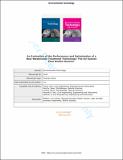An evaluation of the performance and optimization of a new wastewater treatment technology: the air suction flow-biofilm reactor

View/
Date
2014-12-09Author
Forde, P.
Kennelly, Colm
Gerrity, Seán
Collins, Gavin
Clifford, Eoghan
Metadata
Show full item recordUsage
This item's downloads: 263 (view details)
Cited 4 times in Scopus (view citations)
Recommended Citation
Forde, P., Kennelly, C., Gerrity, S., Collins, G., & Clifford, Eoghan. (2015). An evaluation of the performance and optimization of a new wastewater treatment technology: the air suction flow-biofilm reactor. Environmental Technology, 36(9), 1188-1204. doi: 10.1080/09593330.2014.982724
Published Version
Abstract
In this laboratory study, a novel wastewater treatment technology, the air suction flow-biofilm reactor (ASF-BR) - a sequencing batch biofilm reactor technology with a passive aeration mechanism - was investigated for its efficiency in removing organic carbon, nitrogen and phosphorus, from high-strength synthetic wastewaters. A laboratory-scale ASF-BR comprising 2 reactors, 350 mm in diameter and 450 mm in height, was investigated over 2 studies (Studies 1 and 2) for a total of 430 days. Study 1 lasted a total of 166 days and involved a 9-step sequence alternating between aeration, anoxic treatment and settlement. The cycle time was 12.1 h and the reactors were operated at a substrate loading rate of 3.60 g filtered chemical oxygen demand (CODf)/m(2) media/d, 0.28 g filtered total nitrogen (TNf)/m(2) media/d, 0.24 g ammonium-nitrogen (NH4-N)/m(2) media/d and 0.07 g ortho-phosphate (PO4-P)/m(2) media/d. The average removal rates achieved during Study 1 were 98% CODf, 88% TNf, 97% NH4-N and 35% PO4-P. During Study 2 (264 days), the unit was operated at a loading rate of 2.49 g CODf/m(2) media/d, 0.24 g TNf/m(2) media/d, 0.20 g NH4-N/m(2) media/d and 0.06 PO4-P/m(2) media/d. The energy requirement during this study was reduced by modifying the treatment cycle in include fewer pumping cycles. Removal rates in Study 2 averaged 97% CODf, 86% TNf, 99% NH4-N and 76% PO4-P. The excess sludge production of the system was evaluated and detailed analyses of the treatment cycles were carried out. Biomass yields were estimated at 0.09 g SS/g CODf, removed and 0.21 g SS/g CODf, removed for Studies 1 and 2, respectively. Gene analysis showed that the use of a partial vacuum did not affect the growth of ammonia-oxidizing bacteria. The results indicate that the ASF-BR and passive aeration technologies can offer efficient alternatives to existing technologies.

